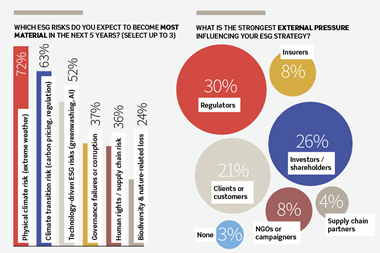Oscar Tempest suggests some strategies to help contain employers' liability costs
The recent increases in the cost of employers' liability (EL) cover prompted a review of liability insurance provision earlier this year by both the UK Department of Work and Pensions and the Office of Fair Trading.
The cause of the situation is well known; it suffices to say that premium rates had been subsidised for many years. This was through a combination of insurers' ability to obtain good returns on investment of premiums received and the inbuilt delays between receipt of premium and payment of related claims. It led to excessive competition between insurers for market share.
The increasing cost of claims, running at between 11% and 13% year on year, much higher than other rates of inflation, was hidden due to these factors. The weakening of the stock market has reduced capacity to write this business. Insurers have now been forced to look to positive underwriting returns, and charge the real cost of insurance.
Government has also played a part by moving expenditure from the public purse to tortfeasors. This continues, as NHS treatment costs are likely to be charged from next year with a maximum of £33,000 per claimant. Insurers will have to start reflecting this cost in their premiums and, since policies are renewable annually, the impact will be felt this year.
Changing relationships
With these changes, the dynamics of the relationship between insurers and insured have altered. Instead of insurers seeking premium income, it is now the quality of the risk that is paramount, with insurers being selective in the risks they write.
To be attractive to an insurer, a company must differentiate favourably between the risk it poses and the average risk within the sector in which it operates.
Points of differentiation
So how can your company differentiate itself as a better quality risk, so that it may ultimately be able to contain its EL costs? The following, while not an exhaustive list, describes relevant criteria.
Health and safety must have a high profile within the organisation. All levels of management from executive to first line supervisor must support health and safety as an integral part of an efficient working environment. There has to be a proactive attitude toward health and safety. This is the 'prevention is better than cure' concept behind recent regulation. The best way to demonstrate this is to ensure assessments have not only been completed but are up-to-date through regular review and audit. You need to have adequate staff training, clear instructions readily available, warnings where the risk cannot be otherwise eliminated and enforcement of use of personal protection and safety equipment where necessary. Establishing the 'paper trail' to back this action up, is essential in order to defend claims. Too often, otherwise challengeable claims have to be settled because the paper records do not exist. It is crucial to show that your company has learned from previous experiences. Have you reviewed accidents and near misses to identify failures as part of ongoing risk assessment? Have you taken the necessary actions to avoid repetition? It is helpful to look at your company's previous claims experience. Does it show a downward or upward trend? Analysing the types of claims may show some common factors which you can tackle as a priority. If a significant or serious accident occurs, do you have effective procedures to enable you to investigate it internally within 24 hours, with witness statements, photographs of the scene and identification of relevant paper records? These will assist insurers in assessing liability. Have you checked the efficacy of the response? When a claim arises you must be prepared to make hard decisions quickly. It is pointless attempting to defend the indefensible. If there is a liability for the injury, authorise your insurers at the earliest possible stage to make an admission. This will help to contain legal costs. Does your organisation have a philosophy of trying to reintegrate those injured or ill back into the workplace? Insurers are currently adopting active rehabilitation techniques to help those injured to maximise their recovery. These types of claim offer a unique opportunity to rehabilitate effectively, by both insurer and employer joining to make a concerted effort to return the injured person to the workforce. Most of this is good risk management practice. However, my own company's experience of handling claims has shown that while these principles are well known, too often they are not effectively practised.
Oscar Tempest is manager, complex loss & technical services team, Iron Trades Insurance Company. www.QBE.com



















